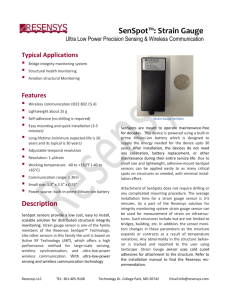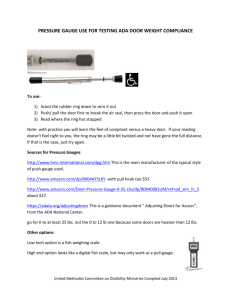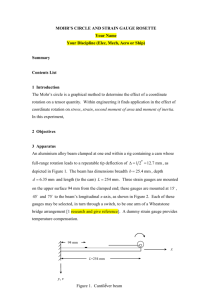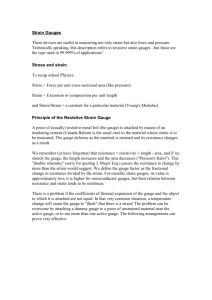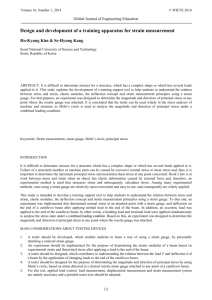Summer 2007 Lab 7 EE100/EE43 EECS 100/43 Lab 7 – Project
advertisement
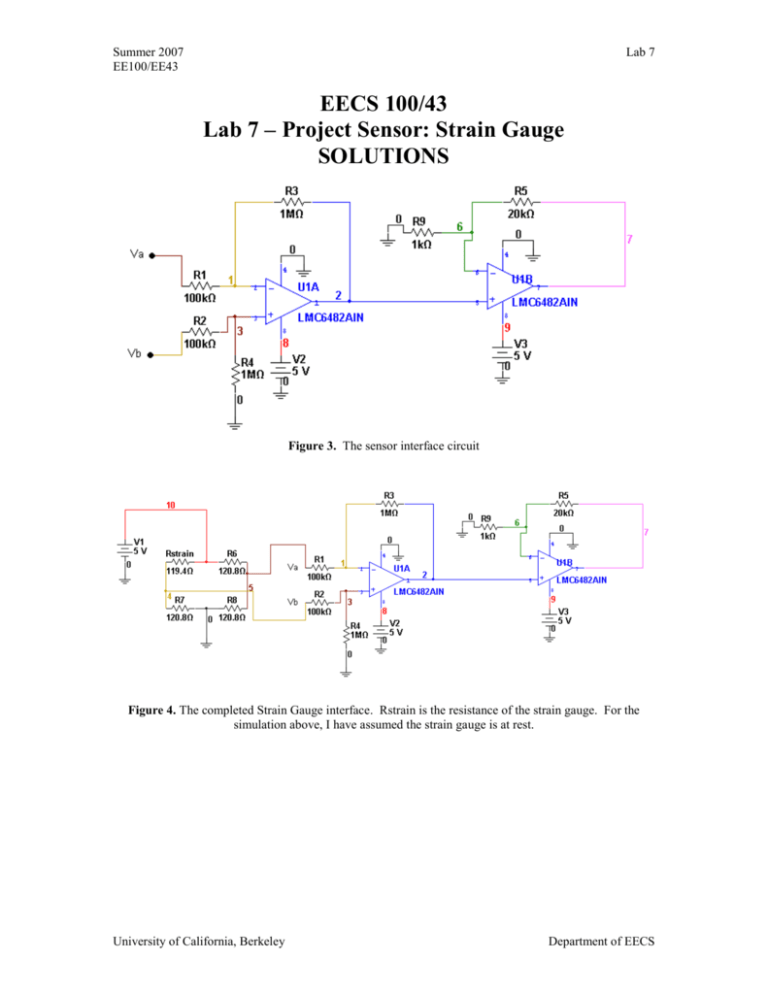
Summer 2007 EE100/EE43 Lab 7 EECS 100/43 Lab 7 – Project Sensor: Strain Gauge SOLUTIONS Figure 3. The sensor interface circuit Figure 4. The completed Strain Gauge interface. Rstrain is the resistance of the strain gauge. For the simulation above, I have assumed the strain gauge is at rest. University of California, Berkeley Department of EECS Summer 2007 EE100/EE43 Lab 7 4. PRELAB SOLUTIONS a. TASK 1 Derive the gains of the two op-amp circuit in figure 3. Fill table 1. Op-amp U1A (Difference amplifier) U1B (Noninverting Amplifier) Gain Expression (in terms of output voltages and input voltages) G1:10 G2:22 Table 1. Theoretical Gain Calculations Show your work here: G1: From p. 165 of your textbook, we can get G1. Notice that in our case, equation (5.23) is valid: R1/R3 = R2/R4. Hence: 1M 1000k (Vb - Va) (Vb - Va) 10(Vb - Va) 100k 100k V2 Therefore, G1 10 Vb - Va V2 G2: This is the gain of the classic non-inverting amplifier. In our case it is: (1+R5/R9) = 22. The total gain is: G = V7/(Vb-Va) = G1 x G2 = _____220________________________ b. TASK 2 Log into the remote server and design the circuit in figure 4 using MultiSim. Record the values of (Vb-Va) and the output voltage (V7) of the non-inverting amplifier from figure 4 in table 2 below (use a simulated Multimeter to measure the voltages). You are simulating push and pull on the strain gauge by changing the value of Rstrain. Rstrain () Vb-Va (V) (from Multsim) V7 (V) (from Multsim) 120.1 119.4 118.7 7.26 x 10-3 14.563 x 10-3 21.908 x 10-3 1.648 3.179 4.722 Simulated Theoretical Gain Gain: G [V7/(Vb-Va)] [From TASK 1] 226 220 218 220 215 220 Table 2. Simulated vs. Theoretical Gain Do you have a nice dynamic range for V7 (i.e..does V7 go from approx. 5 V down to approx. 1.5 V)? YES University of California, Berkeley Department of EECS Summer 2007 EE100/EE43 Lab 7 5. REPORT SOLUTIONS a. TASK 1 Make sure that there is a strain gauge apparatus on your workbench. Out of the 4 strain gauges on the apparatus, pick one. Measure the resistance of the strain gauge at rest, at the maximum pull and maximum push. I recommend that one partner hold the strain gauge on the bench while the other pushes or pulls1. Record your resistance measurements in table 3. Position Maximum Pull Rest Maximum Push Rstrain () 118.7 119.4 120.1 Table 3. Rstrain values that indicate the position b. TASK 2 Based on your measurements, pick a value for R6, R7 and R8 (R6 = R7 = R8) in your Wheatstone bridge from figure 4. Get this value checked off by the TA. R for Wheatstone bridge: _____120 ohms (two 60.4 ohms 1% resistors in series)____ NOTE: I BELIEVE ALL STRAIN GAUGES HAVE THE SAME Rstrain AT REST AND SAME VARIATION IN RESISTANCE UPON PUSH AND PULL. c. TASK 3 Build the circuit shown in figure 4. You may have to change the values of the resistors in the op-amp circuits depending on your strain gauge. The design criterion is that your output voltage at node 7 (V7) in figure 4 should swing from approx. 1.0 V to 5.0 V as you push and pull the strain gauge. SHOULD BE NO SURPRISES HERE. 6. REVISION HISTORY Date/Author Summer 2007/Bharathwaj Muthuswamy Revision Comments Typed up source documentation, organized lab report, typed up solutions. DO NOT APPLY “SUPERHUMAN STRENGTH” ON THE STRAIN GAUGE! If the strain gauge breaks, the person who broke it PAYS for buying a new strain gauge! 1 University of California, Berkeley Department of EECS


